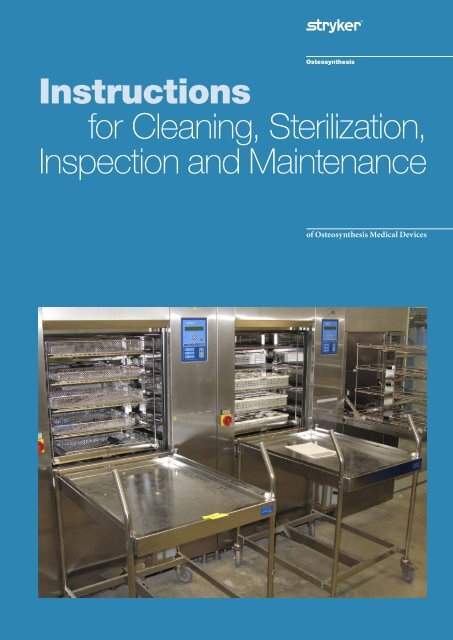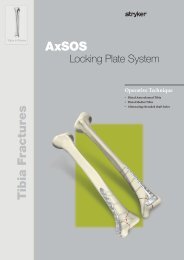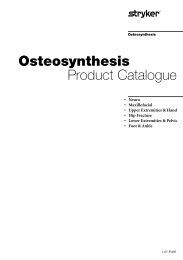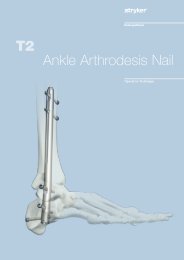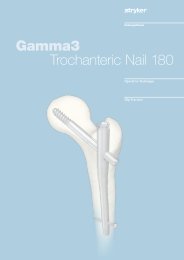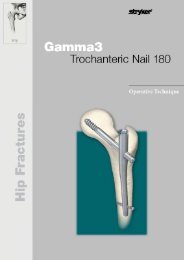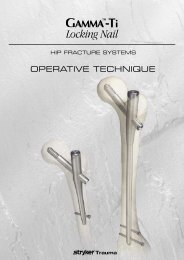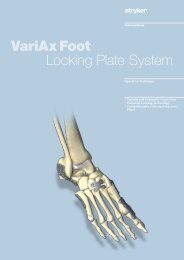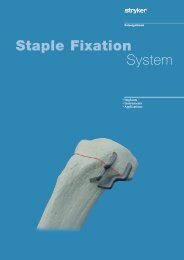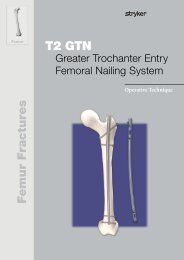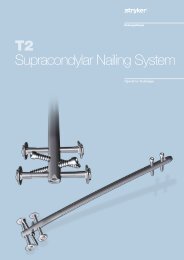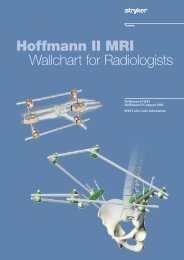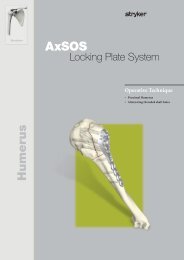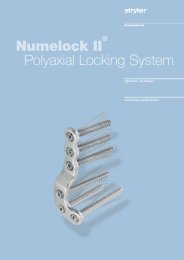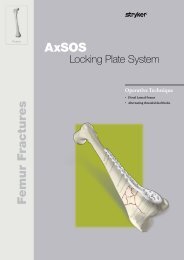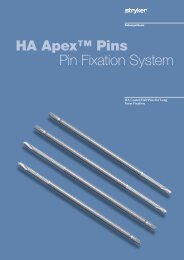Instructions for Cleaning, Sterilization, Inspection and ... - Stryker
Instructions for Cleaning, Sterilization, Inspection and ... - Stryker
Instructions for Cleaning, Sterilization, Inspection and ... - Stryker
You also want an ePaper? Increase the reach of your titles
YUMPU automatically turns print PDFs into web optimized ePapers that Google loves.
<strong>Instructions</strong><br />
<strong>for</strong> <strong>Cleaning</strong>, <strong>Sterilization</strong>,<br />
<strong>Inspection</strong> <strong>and</strong> Maintenance<br />
of Osteosynthesis Medical Devices
Contents<br />
Page<br />
1. Introduction 3<br />
Warnings <strong>and</strong> Precautions 3<br />
2. Processing <strong>Instructions</strong> 4<br />
3. <strong>Cleaning</strong> 5<br />
<strong>Inspection</strong> 8<br />
Packaging 8<br />
4. <strong>Sterilization</strong> 9<br />
5. Storage be<strong>for</strong>e Use 11<br />
6. References 11<br />
7. Manufacturers of <strong>Stryker</strong> Osteosynthesis Medical Devices 11<br />
Appendix 1 12<br />
<strong>Cleaning</strong> agents <strong>and</strong> disinfectants used during validation<br />
of the processing instructions 12<br />
Appendix 2 13<br />
Generic product groups defined <strong>for</strong> the cleaning validation 13<br />
Appendix 3 16<br />
Guidelines to check proper functionality of the medical devices 16<br />
2
1. Introduction<br />
This document is intended to give<br />
general guidance on how medical<br />
devices supplied by one of the <strong>Stryker</strong><br />
Osteosynthesis manufacturing locations<br />
(see manufacturer addresses in<br />
section 7) may be processed to prepare<br />
them <strong>for</strong> use. It also gives instructions<br />
<strong>for</strong> inspection to determine when an<br />
instrument has reached the end of its<br />
serviceable life <strong>and</strong> must be replaced.<br />
This document is provided in conjunction<br />
with the assembly <strong>and</strong> disassembly<br />
instructions <strong>for</strong> multi-component<br />
instruments which must be disassembled<br />
prior to cleaning, <strong>and</strong> the instructions<br />
<strong>for</strong> use, which come with the<br />
products. <strong>Stryker</strong> Osteosynthesis has<br />
demonstrated the processes described<br />
in these instructions to be effective.<br />
Equipment, operators, cleaning agents<br />
<strong>and</strong> procedures all have a contribution<br />
to the efficacy of the processing <strong>and</strong> the<br />
healthcare facility should ensure that<br />
the combination actually in use results<br />
in a medical device which is safe <strong>and</strong><br />
effective <strong>for</strong> use. Alternative methods<br />
of processing may be equally suitable.<br />
In the event of conflicting national<br />
cleaning <strong>and</strong> sterilization requirements,<br />
these shall prevail over <strong>Stryker</strong> Osteosynthesis'<br />
recommendations. This<br />
applies particularly to the different<br />
procedures <strong>for</strong> inactivation of prions.<br />
Warnings <strong>and</strong> Precautions<br />
• Devices labeled “<strong>for</strong> single use<br />
only” must not be reprocessed<br />
<strong>for</strong> re-use. When single use devices<br />
are supplied non-sterile <strong>and</strong> require<br />
sterilization be<strong>for</strong>e use, the appropriate<br />
sections of these instructions<br />
may be applied unless other specific<br />
instructions are provided in the<br />
package insert.<br />
• Single use devices must not be<br />
reused, as they are not designed<br />
to per<strong>for</strong>m as intended after the<br />
first usage. Changes in mechanical,<br />
physical or chemical characteristics<br />
introduced under conditions of<br />
repeated use, cleaning <strong>and</strong> re-sterilization<br />
may compromise the integrity<br />
of the design <strong>and</strong>/or material<br />
leading to diminished safety, per<strong>for</strong>mance<br />
<strong>and</strong>/or compliance with<br />
relevant specifications. Please refer<br />
to the device label to identify single<br />
or multiple use <strong>and</strong>/or cleaning <strong>and</strong><br />
re-sterilization release.<br />
• <strong>Stryker</strong> Osteosynthesis medical<br />
devices are not normally used in<br />
surgical procedures where they<br />
contact low or high risk TSE<br />
(Transmissible Spongi<strong>for</strong>m Encephalophaties)<br />
infective tissue as<br />
defined by World Health Organization<br />
(WHO), Robert Koch Institute<br />
(RKI) etc.. There<strong>for</strong>e decontamination<br />
procedures with highly aggressive<br />
agents [i.e. sodium hydroxide<br />
(NaOH), sodium hypochloride<br />
(NaOCl)] are not necessary <strong>and</strong>, <strong>for</strong><br />
normal processing, are not recommended<br />
because material degradation<br />
may occur. The sterilization<br />
parameters recommended in this<br />
document are not intended <strong>and</strong> not<br />
suitable <strong>for</strong> inactivation of prions.<br />
3
2. Processing <strong>Instructions</strong><br />
The sequence of steps required to<br />
prepare medical devices <strong>for</strong> re-use or to<br />
prepare new devices <strong>for</strong> initial use are<br />
summarized in the chart below.<br />
More detailed instructions <strong>for</strong> each step<br />
are given on the following pages.<br />
Point of Use<br />
Transport to<br />
Processing Area<br />
• Remove gross soil<br />
• Rinse in running water<br />
• Place in aldehyde-free disinfectan bath<br />
• Avoid mechanical damage<br />
• Minimize time be<strong>for</strong>e cleaning<br />
Preparation <strong>for</strong><br />
<strong>Cleaning</strong><br />
• Disassemble where possible<br />
Pre-<strong>Cleaning</strong><br />
• Remove gross soil<br />
• Soak in cleaning solution<br />
• Brush, operate moving parts<br />
• Rinse in running water<br />
• Inspect, place on absorbent paper<br />
Manual<br />
Automatic<br />
(recommended)<br />
Manual <strong>Cleaning</strong> <strong>and</strong><br />
Disinfection<br />
• Soak in ultrasonic bath<br />
• Clean with brushes or cleaning<br />
wires<br />
• Rinse with syringe/running water<br />
• Soak in disinfectant solution<br />
• Clean with brushes<br />
• Rinse with syringe/running water<br />
• Dry (compressed air/wipes/oven)<br />
Automated <strong>Cleaning</strong><br />
<strong>and</strong> Disinfection in<br />
Washer-Disinfector<br />
• Soak in ultrasonic bath<br />
• Load into washer-disinfector<br />
• Connect cannulations<br />
to rinsing ports, arrange<br />
products<br />
• Operate washer-disinfector<br />
cycle<br />
• Inspect, dry<br />
<strong>Inspection</strong><br />
• Visual inspection<br />
• Functional check<br />
Packaging<br />
• Store devices in dedicated trays or wire<br />
baskets<br />
• Single or double packaging<br />
<strong>Sterilization</strong><br />
• Steam autoclave<br />
Storage<br />
• Control environment<br />
• Control shelf life<br />
4
3. <strong>Cleaning</strong><br />
Two methods of cleaning <strong>Stryker</strong><br />
Osteosynthesis medical devices are provided<br />
in these instructions, a manual<br />
method <strong>and</strong> a method using an automated<br />
washer disinfector. Whenever<br />
possible the automated method should<br />
be used. The automated cleaning process<br />
is more reproducible <strong>and</strong> there<strong>for</strong>e<br />
more reliable, <strong>and</strong> staff are less exposed<br />
to the contaminated devices <strong>and</strong> the<br />
cleaning agents used.<br />
Whichever method is used, staff should<br />
use suitable protective clothing <strong>and</strong><br />
equipment at all times. In particular<br />
take note of the instructions provided<br />
by the cleaning agent manufacturer<br />
<strong>for</strong> correct h<strong>and</strong>ling <strong>and</strong> use of the<br />
product.<br />
The guidance concentrations <strong>and</strong> times<br />
<strong>for</strong> device immersion in the cleaning<br />
solutions <strong>and</strong>/or disinfectants given<br />
by the detergent manufacturers shall<br />
be observed. If these concentrations<br />
<strong>and</strong> times are exceeded significantly,<br />
discoloration or corrosion could occur<br />
with some materials. This could also<br />
happen if rinsing after cleaning <strong>and</strong>/or<br />
disinfecting is insufficient.<br />
For cleaning or disinfecting medical<br />
devices only specifically <strong>for</strong>mulated<br />
cleaning agents <strong>and</strong>/or disinfectants<br />
(detergents) should be used.<br />
As not all cleaning agents <strong>and</strong> disinfectants<br />
may be available around<br />
the globe, criteria <strong>for</strong> the selection of<br />
appropriate detergents are provided in<br />
Appendix 1. A list of cleaning agents<br />
<strong>and</strong> disinfectants which <strong>Stryker</strong> Osteosynthesis<br />
used in the validation of these<br />
processing instructions is also provided<br />
in Appendix 1. <strong>Stryker</strong> Osteosynthesis<br />
does not recommend any specific<br />
cleaning <strong>and</strong>/or disinfection agent. A<br />
general description of suitable agents is<br />
included in Appendix 1.<br />
The quality of the water used <strong>for</strong><br />
diluting cleaning agents <strong>and</strong>/or<br />
disinfectants <strong>and</strong> <strong>for</strong> rinsing medical<br />
devices should be carefully considered.<br />
Application of freshly prepared purified<br />
water/highly purified water or sterile<br />
water <strong>for</strong> rinsing purposes (according<br />
to the pharmacopeias) with less than<br />
10 cfu/ml <strong>and</strong> 0.25 EU/ml is highly<br />
recommended.<br />
Mineral residues from hard water as<br />
well as higher contamination with<br />
microorganisms <strong>and</strong> endotoxins can<br />
result in staining of the device or<br />
prevent effective cleaning <strong>and</strong> decontamination.<br />
Caution:<br />
<strong>Stryker</strong> Osteosynthesis trays<br />
are intended <strong>for</strong> sterilization,<br />
transport <strong>and</strong> storage of medical<br />
devices. They are not designed <strong>for</strong><br />
cleaning <strong>and</strong> disinfection in the<br />
fully equipped state. The devices<br />
must be removed from the tray <strong>for</strong><br />
adequate cleaning results.<br />
Point of use<br />
Directly after application (within a<br />
maximum of 2 hours postoperatively)<br />
remove gross soil using absorbent<br />
paper wipes. Additionally, intensive<br />
rinsing of the medical devices with<br />
fluent water or transfer of the medical<br />
devices into a bath with an aldehydefree<br />
disinfectant solution meeting the<br />
criteria given in Appendix 1 is highly<br />
recommended.<br />
Transport to processing area<br />
Avoid mechanical damage, e.g. do not<br />
mix heavy devices with delicate ones.<br />
Pay particular attention to cutting<br />
edges, both to avoid injury <strong>and</strong> damage<br />
to the medical device. Get the medical<br />
devices to the point where cleaning is<br />
to be per<strong>for</strong>med as soon as practical.<br />
If transfer to the processing area is<br />
likely to be delayed, consider covering<br />
the medical devices with a damp cloth<br />
or store the medical devices in closed<br />
boxes to avoid drying of soil.<br />
Preparation <strong>for</strong> cleaning<br />
Disassemble the device where possible.<br />
See instructions provided in the<br />
operative technique or separate in<strong>for</strong>mation<br />
available from your <strong>Stryker</strong><br />
representative.<br />
Pre-<strong>Cleaning</strong><br />
Remark:<br />
The pre-cleaning step can be ommitted<br />
in case of direct subsequent manual<br />
cleaning <strong>and</strong> disinfection. In case of<br />
highly contaminated medical devices to<br />
be subjected to an automatic cleaning<br />
process, pre-cleaning in an ultrasonic<br />
bath is recommended.<br />
Equipment required:<br />
• <strong>Cleaning</strong> bath or vessel large<br />
enough to allow complete immersion<br />
of the instruments.<br />
• Freshly prepared cleaning solution<br />
using a cleaning agent intended <strong>for</strong><br />
manual cleaning which meets the<br />
5<br />
criteria given in Appendix 1, with<br />
concentration, temperature, <strong>and</strong><br />
soaking time not less than specified<br />
in the detergent manufacturer´s<br />
instructions (but temperature not<br />
exceeding 50 °C)<br />
• Brushes – soft <strong>and</strong> firm, bottle brushes<br />
or cleaning wires <strong>for</strong> cannulations<br />
etc.<br />
• Personal protective equipment as<br />
recommended by the cleaning agent<br />
supplier (minimum overalls, gloves,<br />
face/eye shield)<br />
• Absorbent paper<br />
• Syringes (volumes 1 to 50 ml<br />
depending on the size of the cannulations<br />
to be rinsed)<br />
Caution:<br />
Never use metal brushes or steel<br />
wool <strong>for</strong> cleaning.
3. <strong>Cleaning</strong><br />
Procedure<br />
• Remove gross soil using paper<br />
wipes <strong>and</strong> solution of cleaning<br />
agent.<br />
• Immerse medical device in solution<br />
of cleaning agent.<br />
• Ensure that all surfaces are thoroughly<br />
wetted, using a syringe<br />
to ensure that solution reaches all<br />
parts of cannulations etc. Ensure<br />
that air is not trapped within features<br />
of the device when immersing<br />
in the solution.<br />
• Soak at minimum <strong>for</strong> the time<br />
recommended by the detergent<br />
manufacturer´s instructions.<br />
• Using suitable brushes (only soft<br />
brushes, never metal brushes or<br />
steel wool) or cleaning wires clean<br />
the medical device thoroughly<br />
paying particular attention to rough<br />
surfaces <strong>and</strong> features where soil may<br />
be shielded from the brushing.<br />
• Use a firm bristle brush <strong>for</strong> cleaning<br />
bone-cutting features such as drill<br />
tips, reamer flutes <strong>and</strong> the teeth of<br />
broaches.<br />
• Use a bottle brush of appropriate<br />
diameter <strong>for</strong> cannulations. Ensure<br />
that the brush passes the whole<br />
length of each cannulation at least<br />
three times.<br />
• Operate articulating devices <strong>and</strong><br />
those with moving parts.<br />
• Rinse in running water <strong>for</strong> at least<br />
1 min until all traces of cleaning<br />
solution are removed.<br />
• Pay particular attention to cannulations<br />
<strong>and</strong> blind holes as well as<br />
hinges <strong>and</strong> joints between mating<br />
parts. At least three times complete<br />
rinsing by application of a syringe<br />
(volume 1-50 ml) is required.<br />
• Visually inspect <strong>for</strong> any remaining<br />
soil <strong>and</strong> repeat the steps above if<br />
necessary.<br />
• Allow to drain on absorbent paper<br />
or transfer immediately to cleaning<br />
step.<br />
Manual cleaning <strong>and</strong> disinfection<br />
<strong>Cleaning</strong><br />
Equipment required:<br />
• Ultrasonic bath large enough to<br />
allow complete immersion of the<br />
medical device. Frequency 25 – 50<br />
kHz, temperature according to<br />
detergent manufacturer`s instructions.<br />
• <strong>Cleaning</strong> agent intended <strong>for</strong> manual<br />
cleaning <strong>and</strong> suitable <strong>for</strong> ultrasonic<br />
treatment which meets the criteria<br />
given in Appendix 1; concentration<br />
as specified in detergent<br />
manufacturer’s instructions.<br />
• Suitable brushes (only soft brushes,<br />
never metal brushes or steel wool)<br />
or cleaning wires (<strong>for</strong> small channels)<br />
to reach all parts of the device.<br />
• Syringes (volumes 1 to 50 ml<br />
depending on the size of the channels<br />
to be rinsed)<br />
• Freshly prepared purified water/<br />
highly purified water or sterile<br />
water <strong>for</strong> rinsing purposes.<br />
Procedure:<br />
• Prepare an ultrasonic bath with a<br />
cleaning solution at the concentration<br />
<strong>and</strong> temperature specified<br />
in the detergent manufacturer´s<br />
instructions.<br />
• Immerse the device completely<br />
<strong>and</strong> activate the bath <strong>for</strong> at least<br />
the time specified in the detergent<br />
manufacturer´s instructions.<br />
• Using suitable brushes (only soft<br />
brushes, never metal brushes or<br />
steel wool) or cleaning wires (<strong>for</strong><br />
small channels) clean the device<br />
paying particular attention to rough<br />
surfaces <strong>and</strong> features that may be<br />
shielded from the brushing action.<br />
Additionally, pay particular attention<br />
to cannulations <strong>and</strong> blind holes<br />
as well as hinges <strong>and</strong> joints between<br />
mating parts. Rinse cannulations at<br />
least three times with a syringe.<br />
• Rinse <strong>for</strong> at least 1 min in running<br />
water of the specified quality until<br />
all traces of cleaning solution are<br />
removed. Pay particular attention to<br />
cannulations <strong>and</strong> blind holes as well<br />
as hinges <strong>and</strong> joints between mating<br />
parts. Rinse cannulations at least<br />
three times with a syringe (volume<br />
1-50ml).<br />
• If, after completion of the cleaning<br />
step in the ultrasonic bath, encrusted<br />
soil remained on the device<br />
which had to be removed with the<br />
brush, the cleaning step must be<br />
repeated as described above.<br />
Equipment required:<br />
• Bath large enough to allow complete<br />
immersion of the medical<br />
device, temperature according to<br />
detergent manufacturer`s instructions.<br />
• Disinfectant intended <strong>for</strong> manual<br />
disinfection <strong>and</strong> compatible<br />
6
3. <strong>Cleaning</strong><br />
Disinfection<br />
with the applied cleaning detergent<br />
which meets the criteria<br />
given in Appendix 1; concentration<br />
according to the detergent<br />
manufacturer’s instructions.<br />
• Syringes (volumes 1 to 50 ml<br />
depending on the size of the channels<br />
to be rinsed).<br />
• Freshly prepared purified water/<br />
highly purified water or sterile<br />
water <strong>for</strong> rinsing purposes.<br />
• Filtered medical compressed air<br />
(if available) or clean <strong>and</strong> lint-free<br />
single use wipes.<br />
Procedure:<br />
• Prepare a bath with a disinfectant<br />
solution at the concentration <strong>and</strong><br />
temperature specified in the detergent<br />
manufacturer´s instructions.<br />
• Immerse the device completely <strong>for</strong><br />
at least the time specified in the<br />
detergent manufacturer´s instructions.<br />
• Rinse cannulations at least three<br />
times with a syringe.<br />
• Rinse <strong>for</strong> at least 1 min in running<br />
water of the specified quality until<br />
all traces of disinfectant solution<br />
are removed. Pay particular<br />
attention to cannulations <strong>and</strong><br />
blind holes as well as hinges <strong>and</strong><br />
joints between mating parts. Rinse<br />
at least five times with a syringe<br />
(volume 1-50ml).<br />
• Dry the medical device using<br />
medical compressed air <strong>and</strong> clean<br />
<strong>and</strong> lint-free single use wipes (if<br />
required supplemented by postdrying<br />
at a clean place <strong>for</strong> up to<br />
2 hours) or by heating in an oven<br />
below 110°C.<br />
• Visually inspect <strong>and</strong> repeat<br />
complete manual cleaning <strong>and</strong><br />
disinfection if necessary.<br />
Automated cleaning <strong>and</strong> disinfection using washer-disinfector (recommended)<br />
Equipment required:<br />
• Washer-disinfector with fundamentally<br />
approved efficiency (e.g. CE<br />
mark or FDA approval according<br />
to ISO 15883), properly installed,<br />
qualified <strong>and</strong> regularly subjected to<br />
maintenance <strong>and</strong> testing<br />
• Approved thermal disinfection<br />
program (A0 value > 3000 or – in<br />
case of older devices – application<br />
of at least 5 min at 90 °C; chemical<br />
disinfection program not recommended<br />
due to danger of remnants<br />
of the disinfectant on the instruments)<br />
with sufficient rinsing steps<br />
<strong>and</strong> filtered air <strong>for</strong> an active drying<br />
program (application of rinsing<br />
aids not recommended, danger of<br />
remnants)<br />
• Final rinsing/disinfection only with<br />
freshly prepared purified water/<br />
highly purified water<br />
• <strong>Cleaning</strong> agent intended <strong>for</strong><br />
automated cleaning which meets<br />
the criteria given in Appendix 1,<br />
concentration as specified in the<br />
detergent manufacturer’s instructions.<br />
Procedure:<br />
• Load the medical devices into the<br />
washer-disinfector.<br />
• Connect cannulations to the rinsing<br />
ports of the washer-disinfector. If<br />
no direct connection is possible,<br />
locate the cannulations directly on<br />
injector jets or in injector sleeves of<br />
the injector basket.<br />
• Avoid contact between devices<br />
(movement during washing could<br />
cause damage, <strong>and</strong> washing action<br />
could be obstructed).<br />
• Arrange medical devices so that<br />
cannulations are not horizontal <strong>and</strong><br />
blind holes incline downwards (to<br />
assist drainage).<br />
• Articulating devices should be in<br />
the open position.<br />
• Operate the washer-disinfector<br />
cycle.<br />
• On completion unload the washerdisinfector.<br />
Visually inspect each<br />
device <strong>for</strong> remaining soil <strong>and</strong><br />
dryness. If soil remains repeat the<br />
cleaning process including the precleaning<br />
stage. Remaining wetness<br />
may be removed with medical grade<br />
compressed air, clean <strong>and</strong> lintfree<br />
single use wipes (if required<br />
supplemented by post-drying at a<br />
clean place <strong>for</strong> up to 2 hours) or by<br />
heating in an oven below 110°C.<br />
7
3. <strong>Cleaning</strong><br />
<strong>Inspection</strong><br />
Be<strong>for</strong>e preparing <strong>for</strong> sterilization, all<br />
medical devices should be inspected.<br />
Generally un-magnified visual inspection<br />
under good light conditions is<br />
sufficient. All parts of the devices<br />
should be checked <strong>for</strong> visible soil <strong>and</strong>/<br />
or corrosion.<br />
Particular attention should be paid to:<br />
• Soil “traps” such as mating surfaces,<br />
hinges, shafts of flexible reamers.<br />
• Recessed features (holes, cannulations).<br />
• Features where soil may be pressed<br />
into contact with the device, e.g.<br />
drill flutes adjacent to the cutting<br />
tip, sides of teeth on broaches <strong>and</strong><br />
rasps.<br />
• Cutting edges should be checked <strong>for</strong><br />
sharpness <strong>and</strong> damage.<br />
• For devices that may be impacted<br />
check that the device is not damaged<br />
to the extent that it malfunctions<br />
or that burrs have been<br />
produced that could damage tissues<br />
or surgical gloves. *<br />
Functional checks should be per<strong>for</strong>med<br />
where possible:<br />
• Mating devices should be checked<br />
<strong>for</strong> proper assembly.<br />
• Medical devices with moving parts<br />
should be operated to check correct<br />
operation (medical grade lubricating<br />
oil suitable <strong>for</strong> steam sterilization<br />
can be applied as required).<br />
• Rotating instruments (e.g. multiple<br />
use drill bits, reamers) should be<br />
checked <strong>for</strong> straightness (this can<br />
be achieved by simply rolling the<br />
instrument on a flat surface).<br />
• “Flexible” instruments, e.g. IM reamers,<br />
should be checked <strong>for</strong> damage<br />
to the spiral element.*<br />
Note:<br />
<strong>Stryker</strong> Osteosynthesis typically<br />
does not specify the maximum<br />
number of uses appropriate <strong>for</strong><br />
re-usable medical devices. The<br />
useful life of these devices depends<br />
on many factors including the<br />
method <strong>and</strong> duration of each use,<br />
<strong>and</strong> the h<strong>and</strong>ling between uses.<br />
Careful inspection <strong>and</strong> functional<br />
test of the device be<strong>for</strong>e use is<br />
the best method of determining<br />
the end of serviceable life <strong>for</strong><br />
the medical device. However, <strong>for</strong><br />
certain instruments end of life has<br />
been defined, verified <strong>and</strong> specified<br />
with either a number of uses or an<br />
expiration date. See Appendix 3 <strong>for</strong><br />
further details.<br />
Packaging<br />
Where appropriate the cleaned, disinfected,<br />
<strong>and</strong> checked medical devices<br />
should be assembled into the dedicated<br />
trays provided. <strong>Stryker</strong> Osteosynthesis<br />
cases/trays should be double wrapped<br />
according to AAMI/CSR technique.<br />
The packaging <strong>for</strong> terminally sterilized<br />
medical devices should fulfill the following<br />
requirements:<br />
• EN ISO 11607<br />
• Suitable <strong>for</strong> steam sterilization<br />
(temperature resistance up to at<br />
least 141 °C, sufficient steam permeability)<br />
• Sufficient protection of the instruments<br />
as well as of the sterilization<br />
packagings to mechanical damage<br />
* See Appendix 3 <strong>for</strong> further inspection instructions.<br />
8
4. <strong>Sterilization</strong><br />
Caution:<br />
Medical Devices containing thermolabile<br />
materials must not be<br />
exposed to additional loads in the<br />
autoclave.<br />
Steam sterilization (moist heat) is<br />
recommended.<br />
An autoclave cycle has been validated<br />
by <strong>Stryker</strong> as being capable of achieving<br />
sterile medical devices; however autoclave<br />
design <strong>and</strong> per<strong>for</strong>mance can affect<br />
the efficacy of the process. Healthcare<br />
facilities should validate the process<br />
that they use, employing the actual<br />
equipment <strong>and</strong> operators that routinely<br />
process the devices.<br />
<strong>Sterilization</strong> process<br />
Steam autoclave (moist heat) sterilization<br />
using a pre-vacuum (<strong>for</strong>ced<br />
air removal) cycle is recommended.<br />
Autoclaves should comply with the<br />
requirements of, <strong>and</strong> be validated,<br />
maintained <strong>and</strong> checked in accordance<br />
with EN 285/EN 13060, EN ISO 17665,<br />
<strong>and</strong> ANSI AAMI ST79.<br />
<strong>Stryker</strong> has validated an autoclave cycle<br />
<strong>for</strong> sterilization of complete medical<br />
device cases/trays. Instruments shall be<br />
sterilized in the mounting condition<br />
as stored on the tray, i.e. if the brackets<br />
or recessions in the tray are designed<br />
to accommodate multi-component<br />
instruments in their assembled state,<br />
there is no need to disassemble these<br />
instruments <strong>for</strong> sterilization. The process<br />
parameters shown on the right are<br />
validated <strong>and</strong> recommended by <strong>Stryker</strong><br />
Osteosynthesis <strong>for</strong> sterilization:<br />
USA*<br />
Method<br />
Cycle<br />
Temperature<br />
Exposure Time 1<br />
Pressure<br />
Drying Time 2<br />
Cool Time<br />
Outside USA*<br />
Method Moist heat sterilization according to EN ISO 17665<br />
Cycle<br />
Saturated steam with fractional <strong>for</strong>ced air removal<br />
Exposure Time 1<br />
Temperature<br />
Drying Time 2<br />
Moist heat sterilization according to EN ISO 17665 <strong>and</strong> ANSI/<br />
AAMI ST79<br />
Pre-Vacuum (Pre-Vac)<br />
270°F (132°C)<br />
4 minutes<br />
2-15 PSIA<br />
30 minutes (minimum, in chamber)<br />
60 minutes (minimum, at room temperature)<br />
4 minutes<br />
Exposure time can be extended to 18 minutes to comply<br />
with the recommendation from World Health Organization<br />
(WHO), Robert Koch Institute (RKI) etc. <strong>Stryker</strong> Osteosynthesis<br />
medical devices are able to sustain such sterilization<br />
cycles.<br />
132-137°C (270-277°F)<br />
recommended: 30 minutes (minimum, in chamber)<br />
1 Exposure time:<br />
Period <strong>for</strong> which the load <strong>and</strong> entire chamber is<br />
maintained at the sterilization temperature<br />
² Drying time:<br />
Period during which steam is removed from the<br />
chamber <strong>and</strong> the chamber pressure is reduced to<br />
permit the evaporation of condensate from the load<br />
either by prolonged evacuation or by the injection<br />
<strong>and</strong> extraction of hot air or other gases. The drying<br />
time varies due to load configuration, wrapping<br />
method <strong>and</strong> material. It is the hospital´s responsibility<br />
to validate the appropriate drying time with the<br />
sterilization equipment used.<br />
9
4. <strong>Sterilization</strong><br />
Please note that according EN ISO<br />
17665 the final responsibility <strong>for</strong><br />
validation of sterilization techniques<br />
<strong>and</strong> equipment lies directly with the<br />
hospital. To ensure optimal processing<br />
all cycles <strong>and</strong> methods should be<br />
validated <strong>for</strong> different sterilization<br />
chambers, wrapping methods <strong>and</strong>/or<br />
various load configurations.<br />
* Caution:<br />
These parameters are not applicable<br />
to the entire <strong>Stryker</strong><br />
Osteosynthesis portfolio. There<br />
are exceptions <strong>for</strong> which other<br />
validated sterilization cycles are<br />
applicable. These are described in<br />
the instructions <strong>for</strong> use <strong>and</strong> have<br />
binding character. If a product is<br />
supplied without a package insert<br />
<strong>and</strong> if you are in doubt about the<br />
applicable sterilization parameters<br />
<strong>for</strong> a particular product, please<br />
contact the manufacturer. Manufacturer<br />
addresses are provided in<br />
section 7.<br />
Alternative (e.g. UK, NL)*<br />
Method Moist heat sterilization according to EN ISO 17665<br />
Cycle<br />
Exposure Time 1<br />
Temperature<br />
Drying Time 2<br />
Saturated steam with fractional <strong>for</strong>ced air removal<br />
3 minutes<br />
Exposure time can be extended to 18 minutes to comply<br />
with the recommendation from World Health Organization<br />
(WHO), Robert Koch Institute (RKI) etc. <strong>Stryker</strong> Osteosynthesis<br />
medical devices are able to sustain such sterilization<br />
cycles<br />
134°C-138°C (273°F-280°F)<br />
recommended: 30 minutes (minimum, in chamber)<br />
1 Exposure time:<br />
Period <strong>for</strong> which the load <strong>and</strong> entire chamber is<br />
maintained at the sterilization temperature<br />
² Drying time:<br />
Period during which steam is removed from the<br />
chamber <strong>and</strong> the chamber pressure is reduced to<br />
permit the evaporation of condensate from the load<br />
either by prolonged evacuation or by the injection<br />
<strong>and</strong> extraction of hot air or other gases. The drying<br />
time varies due to load configuration, wrapping<br />
method <strong>and</strong> material. It is the hospital´s responsibility<br />
to validate the appropriate drying time with the<br />
sterilization equipment used.<br />
10
5. Storage be<strong>for</strong>e Use<br />
After sterilization, please store the<br />
medical devices in the sterilization<br />
packagings in a dry <strong>and</strong> dust-free place.<br />
The shelf life depends on the sterile<br />
barrier employed, storage manner,<br />
environmental <strong>and</strong> h<strong>and</strong>ling<br />
conditions. A maximum shelf life <strong>for</strong><br />
sterilized medical devices be<strong>for</strong>e use<br />
should be defined by each health care<br />
facility.<br />
6. References<br />
(<strong>for</strong> some countries only)<br />
1. EN ISO 11607 (ANSI AAMI ISO<br />
11607): Packaging <strong>for</strong> terminally<br />
sterilized medical devices (replaced<br />
EN 868-1 <strong>and</strong> ISO 11607)<br />
2. EN ISO 17665 (ANSI AAMI ISO<br />
17665): <strong>Sterilization</strong> of health care<br />
products, moist heat (replaced EN<br />
554 <strong>and</strong> ISO 11134)<br />
3. ANSI/AAMI ST79: Comprehensive<br />
guide to steam sterilization <strong>and</strong><br />
sterility assurance in health care<br />
facilities<br />
4. EN ISO 17664 (ANSI AAMI ST81):<br />
<strong>Sterilization</strong> of medical devices -<br />
In<strong>for</strong>mation to be provided by the<br />
manufacturer <strong>for</strong> the processing of<br />
resterilizable medical devices<br />
5. World Health Organization<br />
(WHO) <strong>and</strong> Robert Koch Institute<br />
(RKI) recommendations regarding<br />
exposure time:<br />
WHO/CDS/CSR/APH/2000.3,<br />
Annex III, section 2, 6.<br />
RKI Communication in "Bundesgesundheitsblatt",<br />
April 2002,<br />
45:376-394, table 11<br />
6. Verbund für angew<strong>and</strong>te Hygiene<br />
e.V. (VAH) Desinfektionsmittel-<br />
Liste, (VAH List of Disinfectants,<br />
replaced the DGHM List of Disinfectants)<br />
Internal validation reports, not <strong>for</strong><br />
public use<br />
7. <strong>Stryker</strong> cleaning / decontamination<br />
validation study; Summary report,<br />
H. Davis, November 2001<br />
8. <strong>Stryker</strong> steam sterilization validation<br />
study; Summary report, H.<br />
Davis, September 2001<br />
9. <strong>Stryker</strong> Trauma GmbH validation<br />
report VAL P0011, VAL P0014<br />
10. <strong>Stryker</strong> Orthopaedics Technical<br />
Report T-878<br />
11. <strong>Stryker</strong> Osteosynthesis Ti2078-09<br />
12. <strong>Stryker</strong> Osteosynthesis Ti2381-09<br />
7. Manufacturers of <strong>Stryker</strong> Osteosynthesis<br />
Medical Devices<br />
<strong>Stryker</strong> Trauma GmbH <strong>Stryker</strong> Trauma AG <strong>Stryker</strong> Leibinger GmbH & Co KG<br />
Prof.-Küntscher-Str. 1 - 5 Bohnackerweg 1 Boetzinger Str. 41<br />
D-24232 Schönkirchen CH-2545 Selzach D-79111 Freiburg<br />
Germany Switzerl<strong>and</strong> Germany<br />
phone: +49-4348-702 0 phone: +41-32-641 6666 phone: +49-761-4512 0<br />
fax: +49-4348-702 172 fax: +41-32-641 6660 fax: +49-761-4512 120<br />
11
Appendix 1<br />
<strong>Cleaning</strong> agents <strong>and</strong> disinfectants used during validation of<br />
the processing instructions<br />
For cleaning <strong>and</strong>/or disinfection of<br />
medical devices manufactured from<br />
aluminium alloys a pH neutral agent<br />
should be used*. Contact with strong<br />
alkaline detergents or solutions containing<br />
iodine or chlorine should be<br />
avoided, since the aluminium can be<br />
chemically attacked <strong>and</strong> the instrument<br />
may be damaged.<br />
For automatic (washer-disinfector)<br />
cleaning mild alkaline agents (up to pH<br />
10.9) should be preferred, however use<br />
only agents recommended <strong>for</strong> use in<br />
these machines.<br />
Notes:<br />
• The cleaning agents listed below<br />
were used by <strong>Stryker</strong> Osteosynthesis<br />
when validating the instructions<br />
<strong>for</strong> processing provided in<br />
this document.<br />
• <strong>Stryker</strong> Osteosynthesis does not<br />
recommend these products in<br />
preference to others that are available.<br />
Other products may per<strong>for</strong>m<br />
equally in conjunction with the<br />
equipment being used.<br />
• The instructions provided by the<br />
supplier of the detergents should<br />
be followed.<br />
• Personal protection <strong>for</strong> operators<br />
should be provided in accordance<br />
with the supplier´s instructions<br />
<strong>and</strong> safety data sheets<br />
• Suitability of alternative agents<br />
should be checked by reference to<br />
the supplier’s in<strong>for</strong>mation <strong>and</strong>/or<br />
physical testing.<br />
In all cases<br />
• follow the indications, instructions<br />
<strong>and</strong> warnings provided by the<br />
supplier of the cleaning agent <strong>and</strong>/<br />
or disinfectant,<br />
• select only detergents intended <strong>for</strong><br />
cleaning <strong>and</strong>/or disinfection of<br />
medical devices made of metals <strong>and</strong><br />
plastics, <strong>and</strong><br />
• select only disinfectants with approved<br />
efficiency (VAH/DGHM or<br />
FDA approval or CE mark).<br />
Agents <strong>for</strong> pre-cleaning <strong>and</strong> manual cleaning (used <strong>for</strong> validation)<br />
Supplier Designation Comment<br />
Johnson <strong>and</strong> Johnson Cidezyme/Enzol Suitable <strong>for</strong> aluminium<br />
instruments<br />
Agents <strong>for</strong> manual disinfection (used <strong>for</strong> validation)<br />
Supplier Designation Comment<br />
Ensure that the substances listed below<br />
are not ingredients of the cleaning or<br />
disinfection detergent chosen:<br />
• organic, mineral, <strong>and</strong> oxidizing<br />
acids (minimum admitted<br />
pH-value 5.5)<br />
• strong lye (maximum admitted pHvalue<br />
10.9*)<br />
• organic solvents (<strong>for</strong> example:<br />
acetone, ether, alcohol, benzine)<br />
• oxidizing agents (<strong>for</strong> example: peroxides,<br />
hypochloride)<br />
• halogens (chlorine, iodine,<br />
bromine)<br />
• aromated, halogenated hydrocarbons.<br />
Johnson <strong>and</strong> Johnson Cidex OPA Suitable <strong>for</strong> aluminium<br />
instruments<br />
Agents <strong>for</strong> automatic cleaning/disinfection in a washer<br />
disinfector (used <strong>for</strong> validation)<br />
Supplier Designation Comment<br />
Dr. Weigert<br />
neodisher Mediclean<br />
<strong>for</strong>te<br />
Not recommended <strong>for</strong> aluminium<br />
medical devices*<br />
* In case of aluminium instruments neutral/enzymatic<br />
detergents are recommended<br />
(<strong>for</strong> example Neodisher Medizym)<br />
12
Appendix 2<br />
Generic product groups defined <strong>for</strong> cleaning validation<br />
For cleaning <strong>and</strong> sterilization validations,<br />
<strong>Stryker</strong> Osteosynthesis typically<br />
applies a "worst case" approach, i.e. the<br />
most challenging products are selected<br />
as representative test samples. For<br />
the cleaning validation we defined the<br />
following generic product groups:<br />
Group I<br />
One piece instruments<br />
Group II<br />
Instruments <strong>for</strong> bone cutting, piercing<br />
or scraping<br />
Group III<br />
Cannulated instruments<br />
Group I – One piece instrument<br />
Article number Description Report<br />
1806-2035 PHN Target Device TI2078/09<br />
62-51217 Drill Guide TI2078/09<br />
1806-0170 Hammer TI2078/09<br />
12-30180 Bi-polar Forceps, Bayonet TI2078/09<br />
- PPSU Templates TI1737/07<br />
- VariAx Trials TI2347/09 <strong>and</strong><br />
TI2346/09<br />
56-10X10 VariAx DR Aiming Block TI2881/11<br />
1806-1001 T2 Tibia Targeting Arm 171111CG2<br />
Group IV<br />
Multi-component instruments<br />
Group V<br />
Flexible instruments<br />
Group VI<br />
Storage trays<br />
Group VII<br />
Implants<br />
With these product groups <strong>Stryker</strong><br />
Osteosynthesis is covering the<br />
division's entire portfolio <strong>and</strong> the processing<br />
instructions can be presented in<br />
a generic <strong>for</strong>m. Specific instructions <strong>for</strong><br />
each product would not give the health<br />
care professional or sterilization facility<br />
any additional benefit.<br />
The representative products listed<br />
below were used in the validation.<br />
Group II – Instruments <strong>for</strong> bone cutting, piercing or scraping<br />
Article number Description Report<br />
702807 Tap dia 6.5 × 180mm TI2078/09<br />
08-01020 Nasal Rasp, fine / very fine TI2078/09<br />
1806-3026 Stepdrill TI2078/09<br />
0226-4200 Bixcut IM Reamer Head with Dovetail,<br />
dia 20<br />
TI2078/09<br />
Group III – Cannulated Instruments<br />
Article number Description Report<br />
12-04239 Suction Tube, extra long TI2078/09<br />
01-19510 M<strong>and</strong>ibular Channel Retractor,<br />
TI2078/09<br />
Bremerich<br />
1806-3065 5mm, Spreading Screwdriver TI2078/09<br />
1320-0190 Gamma3 Stepdrill TI2078/09<br />
45-20001 Cannulated Screwdriver 2.0mm,<br />
TI1448/07<br />
AO coupling<br />
45-20006 Cannulated Tap 2.0mm, AO coupling TI1448/07<br />
13
Appendix 2<br />
Group IV – Multi-component instruments<br />
Article number Description Report<br />
4920-1-010 Hoffmann II Rod to Rod Coupling TI2078/09<br />
4960-3-000 Hoffmann II Micro Lengthener Assembly TI2078/09<br />
702428 Elastosil H<strong>and</strong>le, small TI2078/09, BML 08037<br />
703566 AxSOS Tibia Targeting Arm TI2078/09<br />
4936-9-010 Tenxor Wire Tensioner TI2078/09, BML 08037<br />
0730400 Reposition Clamp TI2078/09<br />
62-20125 Plate Cutting Pliers TI2078/09<br />
5057-6-300 Pin Cutter TI2078/09<br />
62-20295 Screwdriver H<strong>and</strong>le, revolving, rigid TI2078/09<br />
702628 Elastosil T-H<strong>and</strong>le TI2078/09<br />
6514-7-102 Luhr-Fritzemeier TI1728/07<br />
0193-3600 Large Locking Forceps BSL Bioservice 084292 + 084293<br />
704050 Omega3 TSP Aiming Block BML08-041<br />
702778 AxSOS H<strong>and</strong>le BML08-216<br />
13-19410 Scissors straight TI2451/10<br />
62-00082/ 62-00081 Activation Rod (MID II) TI2262<br />
62-50101 Quick Drive Mini TI2076/09<br />
1320-5340/-50, -60 Gamma3 DTS Adjusting Device 240608CB9<br />
69-1022074 T2 Guide Wire Pusher SMP Report no 00810011401<br />
SK1-913-07 One-Piece Target Sleeve SMP Report no 04808011403<br />
SK1-08-776 T2 Guide Wire Ruler SMP Report no 16308012611<br />
SK1-08-989 Gamma3 U-Blade Extractor SMP Report no 18108012612<br />
62-00400 Universal Check Retractor with Light Source TI2767/11<br />
62-00412 Universal M<strong>and</strong>ible Fracture Plate Holding Foreceps TI2767/11<br />
62-00400 Universal Trocar H<strong>and</strong>le TI2925/11<br />
56-01210 VariAx DR Aiming Block Fixation Pin TI2881/11<br />
56-01310 VariAx DR Aimimng Block Joystick TI2881/11<br />
4933-0-1XX Hoffmann LRF Telescopic Strut BML11-234<br />
Group V – Flexible Instruments<br />
Article number Description Report<br />
1150-0300 Reamer Shaft TI2078/09<br />
0227-8510 Flexible Reamer Shaft, 8mm TI2078/09<br />
1806-0073 Teflon Tube TI2078/09<br />
1320-0233 Gamma3 Flexible Screwdriver MDS Test Report 081727-10-A <strong>and</strong> B,<br />
Test Report 230408CG1<br />
14
Appendix 2<br />
Group VI – Storage trays<br />
Article number Description Report<br />
29-32400 Asnis Micro Tray TI2078/09<br />
29-13009 VariAx H<strong>and</strong> level 4 container TI2078/09<br />
901585, 901587, 901584, 901588 Asnis III, 6.5 & 8.0 trays TI2078/09<br />
902913 AxSOS Targeting 5.0mm instrument tray TI2078/09<br />
- Inlays VariAx H<strong>and</strong> SMP report no. 09606011411<br />
- Screw Racks TI1504/07<br />
- Inlays VariAx Foot TI1504/07<br />
29-30015 Silicone Mat TI2042/09<br />
902855 MMT VariAx Elbow EPS 150408CG1<br />
902845 MMT AxSOS Targeting Proximal Lateral Tibia 210307CG3<br />
902846 MMT AxSOS Targeting 4.0mm Instruments 210307CG3<br />
1768F955 Asnis Micro Screw Rack TI1424/07<br />
1320-9550/ -60 Gamma3 DTS Tray R1.5/ R2.0 240608CB7<br />
29-13125 VariAx DR Aiming Block Tray Insert TI2881/11<br />
29-27005 VariAx DR Implant Module TI3114/11 (automated)<br />
29-27005 VariAx DR Implant Module TI3186/11 (manual)<br />
29-15332 Neuro 3 Instrument Inlay TI3117/11<br />
26-15336 Neuro 3 Screw Disc Inlay TI3117/11<br />
29-15954 Neuro Screw Disc TI3117/11<br />
Group VII – Implants<br />
Article number Description Report<br />
1732-1248 (S) S2 Femoral Nail A/R,<br />
TI2381/09<br />
dia 12 × 480mm<br />
1832-3830 (S) T2 Proximal Humerus Nail, long,<br />
TI2381/09<br />
dia 8 × 300mm<br />
1859-5120 (S) Condyle Screw, dia 5 × 120mm TI2381/09<br />
436008 AxSOS Distal Radius Plate 3.0 TI2381/09<br />
SHBIP9TS<br />
Numelock II 4.5 Distal Medial<br />
TI2381/09<br />
Humerus Plate<br />
326780 Asnis III 8.0 / 180mm, St TI2381/09<br />
40-20230 Asnis Micro 2.0mm Cannulated Screw, length 30mm TI2381/09<br />
5425393 VariAx Distal Radius Universal Volar DR Plate, wide, extra TI2381/09<br />
long<br />
92-15904 Screw 1.5 × 4mm, self drilling (Neuro) TI2381/09<br />
50-20362 MMF Screw, self drilling 2.0 × 12mm TI2381/09<br />
55-10580 Locking Osteotomy Plate TI2381/09<br />
55-28934 Full Secondary Recon Plate TI2381/09<br />
55-28100 Condyle Prosthesis TI2381/09<br />
92-00647 Pre-bent Mesh <strong>for</strong> 1.7 / 1.9mm Screws TI2381/09<br />
629164, 629088 VariAx Elbow Plates BML09-424<br />
62-00435, 62-00420 MID Distractor TI2262<br />
340638 Cortex Screw S.T: 4.5 × 38mm BML08-144<br />
15<br />
This list will be updated periodically.
Appendix 3<br />
Guidelines to check proper functionality of the<br />
medical devices<br />
The following guidelines should be<br />
applied to all <strong>Stryker</strong> Osteosynthesis<br />
instruments which are labeled <strong>for</strong><br />
multiple use. All functional checks <strong>and</strong><br />
inspections described below also cover<br />
the interfaces with other instruments<br />
or components.<br />
The failure modes below may be caused<br />
by end of life of the product, improper<br />
use or improper maintenance.<br />
<strong>Stryker</strong> Osteosynthesis does not typically<br />
specify the maximum number of<br />
uses <strong>for</strong> re-usable medical devices. The<br />
useful life of these devices depends on<br />
many factors including the method <strong>and</strong><br />
duration of each use, <strong>and</strong> the h<strong>and</strong>ling<br />
between uses. Careful inspection <strong>and</strong><br />
functional test of the device be<strong>for</strong>e use<br />
is the best method of determining the<br />
end of serviceable life <strong>for</strong> the medical<br />
device. However, <strong>for</strong> certain instruments<br />
end of life has been defined,<br />
verified <strong>and</strong> specified with either a<br />
number of uses or an expiration date.<br />
Functional check <strong>for</strong> multiple<br />
use Drill Bits<br />
Coupling end eroded<br />
Description <strong>and</strong> Function:<br />
Multiple use drill bits, cannulated drill<br />
bits, burrs, taps, core drills<br />
Potential Failure Modes:<br />
• Defective coupling end (eroded)<br />
• Blunt <strong>and</strong> dull cutting flutes<br />
• Tips, helix coil, bent<br />
Preventive Maintenance:<br />
Such instruments are recommended as<br />
single patient use.<br />
Regular functional check <strong>and</strong> visual<br />
inspection. In case of failure, the<br />
instrument must be replaced <strong>and</strong> not<br />
be used.<br />
Blunt / dull tip<br />
Please check at tip of drill (see mark)<br />
Dents on cutting flutes<br />
16
Appendix 3<br />
Drill Bit: Overview<br />
Drill bit: twisted<br />
Drill bit: blunt / dull cutting flutes<br />
Drill bit:<br />
helix coil - the cutting flutes change<br />
direction<br />
Drill bit: blunt / dull cutting flutes <strong>and</strong><br />
helix<br />
17
Appendix 3<br />
Functional Check <strong>for</strong> Reamers<br />
Description <strong>and</strong> Function:<br />
Intramedullary reamer, reamer heads,<br />
reamer shaft<br />
Reamer shaft: de<strong>for</strong>med<br />
Potential Failure Modes:<br />
• Defective coupling end<br />
• Blunt <strong>and</strong> dull cutting flutes<br />
• Tips, helix coil of reamer shaft<br />
de<strong>for</strong>med<br />
Preventive Maintenance:<br />
Regular functional check <strong>and</strong> visual<br />
inspection. In case of failure, the instrument<br />
must be replaced <strong>and</strong> not be used.<br />
If soil is not removed from shafts right<br />
after use, incrustation is likely to occur<br />
which will be baked permanently in<br />
subsequent sterilizations.<br />
Reamer bit: blunt / dull cutting flutes<br />
Chunking in cutting flutes<br />
Blunt / dull cutting flutes <strong>and</strong> tip<br />
18
Appendix 3<br />
Functional Check <strong>for</strong> Screwdriver Blades<br />
Description <strong>and</strong> Function:<br />
Screwdrivers with drive connections of<br />
various designs with or without selfretaining<br />
function.<br />
Potential Failure Modes:<br />
• De<strong>for</strong>mation of the blade (twisted)<br />
• De<strong>for</strong>mation of the blade<br />
(rounded)<br />
• Breakage of the blade´s self-retaining<br />
mechanism without function<br />
• Corresponding drive connection<br />
of screw head is rounded or worn.<br />
Preventive Maintenance:<br />
Use an appropriate instrument spray<br />
<strong>for</strong> the mechanism of the self-retaining<br />
screwdrivers. Regular functional check<br />
<strong>and</strong> visual inspection. Replace <strong>and</strong> do<br />
not use in case of failure. Regular functional<br />
check of corresponding items<br />
(screwdrivers - screws).<br />
Hexagon drive connection: fractured<br />
Hexagon drive connection: de<strong>for</strong>med<br />
Hexagon drive connection: rounded<br />
19
Appendix 3<br />
Hexagon drive connection: de<strong>for</strong>med<br />
Hexagon drive connection: de<strong>for</strong>med<br />
Gamma Lag Screwdriver: de<strong>for</strong>med/<br />
broken off pegs<br />
20
Appendix 3<br />
Connection rod of Gamma Lag Screw<br />
Driver: damaged <strong>and</strong> squeezed thread<br />
As above<br />
As above<br />
Functional Check <strong>for</strong> Torque Limiters<br />
Description <strong>and</strong> Function:<br />
Includes all torque limiting or indicating<br />
devices with or without a releasing<br />
mechanism.<br />
Potential Failure Modes:<br />
• Malfunction due to wear<br />
• Corrosion or contamination<br />
Preventive Maintenance:<br />
Use an appropriate instrument spray<br />
<strong>for</strong> the mechanism of the self-retaining<br />
screwdrivers. Frequent control of<br />
torque accuracy with torque tester,<br />
if indicated regular functional <strong>and</strong><br />
visual inspection. In case of failure, the<br />
instrument must be replaced <strong>and</strong> not<br />
be used.<br />
21
Appendix 3<br />
Functional Check <strong>for</strong> Bending Instruments<br />
Description <strong>and</strong> Function:<br />
Instruments used <strong>for</strong> bending implants<br />
Potential Failure Modes:<br />
• Corrosion between adjacent surfaces<br />
• Corrosion between pairings of<br />
different metals<br />
• Corrosion on frequently used<br />
functional surfaces<br />
• Corrosion on the laser engraving<br />
• Bent or damaged edges imply a<br />
risk of damaging the implant,<br />
especially in functional area<br />
Preventive Maintenance:<br />
Regular functional check <strong>and</strong> visual<br />
inspection. Use an appropriate instrument<br />
spray <strong>for</strong> the mechanism of all<br />
moving parts <strong>and</strong> articulating surfaces.<br />
Check <strong>and</strong> if necessary eliminate all<br />
gaps <strong>for</strong> residuals <strong>and</strong> moisture after<br />
usage or cleaning. In case of failure, the<br />
instrument must be replaced <strong>and</strong> not<br />
be used.<br />
Bending Forceps with surface corrosion<br />
at cutting device <strong>and</strong> in the gap between<br />
the two parts of the <strong>for</strong>ceps.<br />
Slight corrosion at the laser engraving<br />
22
Appendix 3<br />
Functional Check <strong>for</strong> Scissors <strong>and</strong> Cutting Instruments<br />
Description <strong>and</strong> Function:<br />
All instrument which are used to cut<br />
tissue <strong>and</strong> bone material (like scissors<br />
or osteotomes) <strong>and</strong> also all instruments<br />
which are used to cut implants (like<br />
cutters)<br />
Potential Failure Modes:<br />
• Cutting edge is damaged, cutting<br />
function is no longer fully given<br />
• Spring is damaged, articulation<br />
does not work properly<br />
Preventive Maintenance:<br />
Use an appropriate instrument spray<br />
<strong>for</strong> the mechanism of all moving parts<br />
<strong>and</strong> articulating surfaces.<br />
H<strong>and</strong>le the instruments with care.<br />
The cutting edge of the instrument<br />
should be inspected prior to clinical<br />
use. The cutting function could be<br />
restricted if the cutting edge or the tip<br />
of the instrument is damaged.<br />
<strong>Stryker</strong> recommends the use of<br />
silicone-free, non-mineral oil based<br />
lubricant <strong>for</strong> the maintenance of<br />
articulated instruments. In case<br />
of failure, the instrument must be<br />
replaced <strong>and</strong> not be used.<br />
Tip of a scissors<br />
Damaged tip of a pair of scissors - cutting<br />
function could be restricted<br />
Damaged cutting edge -<br />
cutting function could be restricted<br />
In situ cutter<br />
Damaged spring -<br />
articulation function restricted<br />
23
Appendix 3<br />
Functional Check <strong>for</strong> Targeting Devices<br />
Description <strong>and</strong> Function:<br />
Target Devices to aim at the locking<br />
holes of implants (nails, plates)<br />
Potential Failure Modes:<br />
• Marks caused by hitting on the<br />
device<br />
• Cracks in the polymer<br />
• Damage of threads<br />
• De<strong>for</strong>mation of nail adapter<br />
• Displacement of connection pin<br />
Preventive Maintenance:<br />
Use an appropriate instrument spray<br />
<strong>for</strong> the mechanism of all moving parts<br />
<strong>and</strong> articulating surfaces. H<strong>and</strong>le with<br />
care. Do not hit on Target Devices. In<br />
case of failure, the instrument must be<br />
replaced <strong>and</strong> not be used.<br />
Marks on the metal part of the device<br />
Crack in the polymer<br />
Hit marks on functional surface<br />
Crack<br />
24
Appendix 3<br />
De<strong>for</strong>mation of nail adapter<br />
Damaged threads<br />
Connection pin displaced (should be<br />
flush with surface)<br />
25
Appendix 3<br />
Functional Check <strong>for</strong> Drill Guides<br />
Description <strong>and</strong> Function:<br />
Soft tissue protection sleeves used<br />
during drilling<br />
Potential Failure Modes:<br />
• Scratched outer surfaces, dents at<br />
the sleeve tips<br />
Preventive Maintenance:<br />
Use an appropriate instrument spray<br />
<strong>for</strong> the mechanism of all moving parts<br />
<strong>and</strong> articulating surfaces. In case of failure,<br />
the instrument must be replaced<br />
<strong>and</strong> not be used.<br />
Drill Guide: overview<br />
Drill Guide Sleeve: dents on the sleeve<br />
tip<br />
Soft Tissue Protector: overview<br />
Tissue Protection Sleeve: dents on the<br />
sleeve tip<br />
Drill Guide Sleeve: scratches on the<br />
surface<br />
Soft Tissue Protector: dents on the soft<br />
tissue protector tips<br />
Tissue Protection Sleeve: surface damaged by assembly part<br />
Drill Guide: dents on the drill guide tip<br />
26
Appendix 3<br />
Functional Check <strong>for</strong> Forceps, Clamps <strong>and</strong> Holding Instruments<br />
Description <strong>and</strong> Function:<br />
• Repositioning of bone fragments<br />
• Clamping of wire after the wire has<br />
been put under tension with the<br />
wire tensioner<br />
Potential Failure Modes:<br />
• De<strong>for</strong>med functional surfaces<br />
(e.g. teeth <strong>and</strong> locking mechanism)<br />
• Clearance between the h<strong>and</strong>les<br />
• Corrosion between adjacent surfaces<br />
• Corrosion between pairings of<br />
different components<br />
• Corrosion on frequently used<br />
functional surfaces<br />
• Corrosion on the laser engraving<br />
• Corrosion of clamping disk may<br />
lead to breakage of the disk when<br />
put under stress<br />
Preventive Maintenance:<br />
Use an appropriate instrument spray<br />
<strong>for</strong> the mechanism of all moving parts<br />
<strong>and</strong> articulating surfaces. In case of failure,<br />
the instrument must be replaced<br />
<strong>and</strong> not be used.<br />
Always examine the wire post <strong>and</strong> especially<br />
the clamping disk be<strong>for</strong>e reuse.<br />
In case of corrosion signs or crack, the<br />
wire post shall not be used.<br />
Bent teeth <strong>and</strong> damaged locking mechanism on a <strong>for</strong>ceps<br />
De<strong>for</strong>med h<strong>and</strong>les on a <strong>for</strong>ceps<br />
Stress corrosion on clamping disc of<br />
Tenxor wire tensioner<br />
Bent teeth of a <strong>for</strong>ceps<br />
27
Notes<br />
28
Notes<br />
29
Notes<br />
30
Notes<br />
31
<strong>Stryker</strong> Trauma GmbH<br />
Prof.-Küntscher-Straße 1–5<br />
D - 24232 Schönkirchen<br />
Germany<br />
<strong>Stryker</strong> Trauma AG<br />
Bohnackerweg 1<br />
CH - 2545 Selzach<br />
Switzerl<strong>and</strong><br />
<strong>Stryker</strong> Leibinger GmbH & Co KG<br />
Bötzinger Straße 41<br />
D - 79111 Freiburg<br />
Germany<br />
www.osteosynthesis.stryker.com<br />
This document is intended solely <strong>for</strong> the use of healthcare professionals. A surgeon must always rely on his or her<br />
own professional clinical judgment when deciding whether to use a particular product when treating a particular<br />
patient. <strong>Stryker</strong> does not dispense medical advice <strong>and</strong> recommends that surgeons be trained in the use of any<br />
particular product be<strong>for</strong>e using it in surgery. The in<strong>for</strong>mation presented is intended to demonstrate a <strong>Stryker</strong><br />
product. A surgeon must always refer to the package insert, product label <strong>and</strong>/or instructions <strong>for</strong> use, including<br />
the instructions <strong>for</strong> <strong>Cleaning</strong> <strong>and</strong> <strong>Sterilization</strong> (if applicable), be<strong>for</strong>e using any <strong>Stryker</strong> product. Products may<br />
not be available in all markets because product availability is subject to the regulatory <strong>and</strong>/or medical practices<br />
in individual markets. Please contact your <strong>Stryker</strong> representative if you have questions about the availability of<br />
<strong>Stryker</strong> products in your area.<br />
<strong>Stryker</strong> Corporation or its divisions or other corporate affiliated entities own, use or have applied <strong>for</strong> the following<br />
trademarks or service marks: Asnis, AxSOS, Bixcut, Gamma, Gamma3, Hoffmann, Luhr, Numelock, Omega3, S2,<br />
<strong>Stryker</strong>, T2, VariAx.<br />
All other trademarks are trademarks of their respective owners or holders.<br />
The products listed above are CE marked.<br />
Literature Number : L24002000-en Rev J1612<br />
Copyright © 2012 <strong>Stryker</strong>


